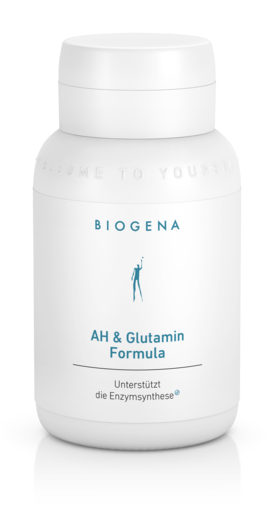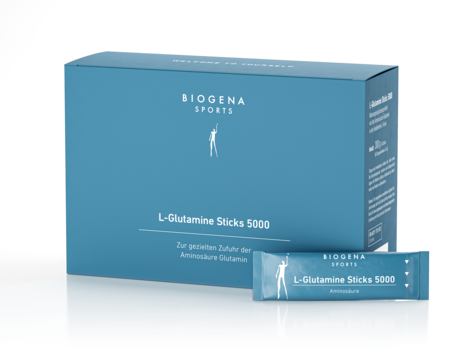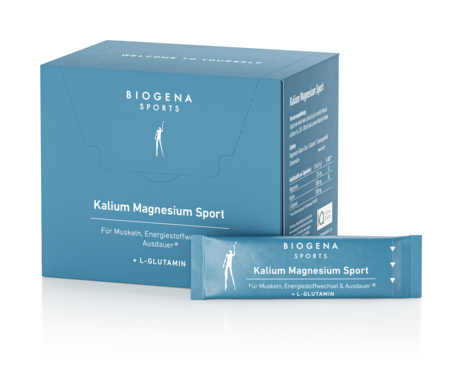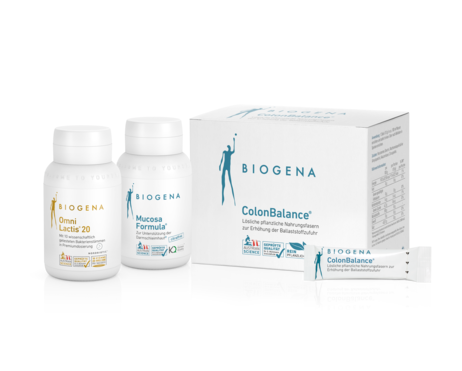L-Glutamine
Glutamine, as one of the non-essential amino acids is formed by the body itself. L-glutamine is also contained in food. However, this is not always sufficient to maintain the stores of glutamine at the level required.


Essential for metabolism and water balance
L-glutamine is a non-essential amino acid for humans and was first described in 1877. In certain situations, an increased intake of L-glutamine may be required. Strenuous physical training, stress, infections, and other special life conditions often consume more of this amino acid than can be replenished.
Proteinogenic amino acid for metabolism
The German chemist Ernst Schulze described L-glutamine as early as 1877. The amino acid is found in the blood plasma. There, it represents the main component of free amino acids at around 20%. However, the highest concentration is detected in the muscle cells. L-glutamine is important to regulate water retention in the cells; in the case of high physical strain, it causes the cell volume to increase. It is proteinogenic and therefore essential for the synthesis of many protein-like substances. The metabolism of all living beings is dependent on glutamine.
L-glutamine from food
In addition to the body's glutamine, we absorb this valuable amino acid from a balanced diet. We get around 5 to 10 grams of our food every day.
In addition, mung beans, lamb, pork, quark, and yogurt also contain considerable amounts of the non-essential amino acid L-glutamine.
L-glutamine in food
Particularly glutamine-rich and therefore not just popular with fitness fans and athletes:
Food Glutamine (mg/100 g)
Cheese 3050–8100
Soya beans 6490
Peanuts 5630
Spelt flour 5170
Lentils 4490
Beef 4130
Wheat flour 4080
Low-fat quark 2878
Difference between L-glutamine and glutamate
Glutamate is mainly known in Asian cuisine and ready-made soups and sauces. These are salts from glutamic acid, which is closely related to L-glutamine, but which differ materially from this. Glutamate must be labeled as a food additive.
Additional need in special life situations
Although the chances of supplying the body with the necessary L-glutamine are good through a balanced diet, the amount taken and produced by the body itself is not always sufficient. Certain phases and lifestyle habits such as
- Illness
- Infections
- Operations
- Accidents
- Stress
- Psychological stresses
not only deplete vitamin and mineral stores, they are often accompanied by an increased need for or a decrease in the glutamine level.
L-Glutamine and exercise
Excessive muscle building and competitive sports can also cause a lower glutamine level. After intensive training, glutamine is first released in the muscle so that the concentration of glutamine in the blood is restored. This can lead to a reduction in muscle mass.
Glutamine levels may decrease to approximately half of their normal levels, depending on the effects of these extraordinary stresses on the body. However, glutamine synthesis is not increased reactively. Supplementation can contribute significantly to the fact that this either does not happen at all or is compensated more quickly.
L-glutamine and diets
L-glutamine deficiency can be caused by strict diets for weight loss, but also in a diet without animal ingredients. In the case of weight-loss diets, glutamine suppliers such as cheese and nuts are often cut out. Calories are thus saved, but the supply of essential proteins and thus L-glutamine could be endangered.
Pure plant-based diet
A balanced diet is essential for vegans to ensure the necessary protein intake. However, if there is also hypersensitivity to nuts and soy products in addition to avoiding animal products, it becomes more difficult to keep healthy merely with the body's glutamines and those absorbed by food. High-quality glutamine with the bioidentical L-form as a nutritional supplement can be a valuable source of this amino acid here.













